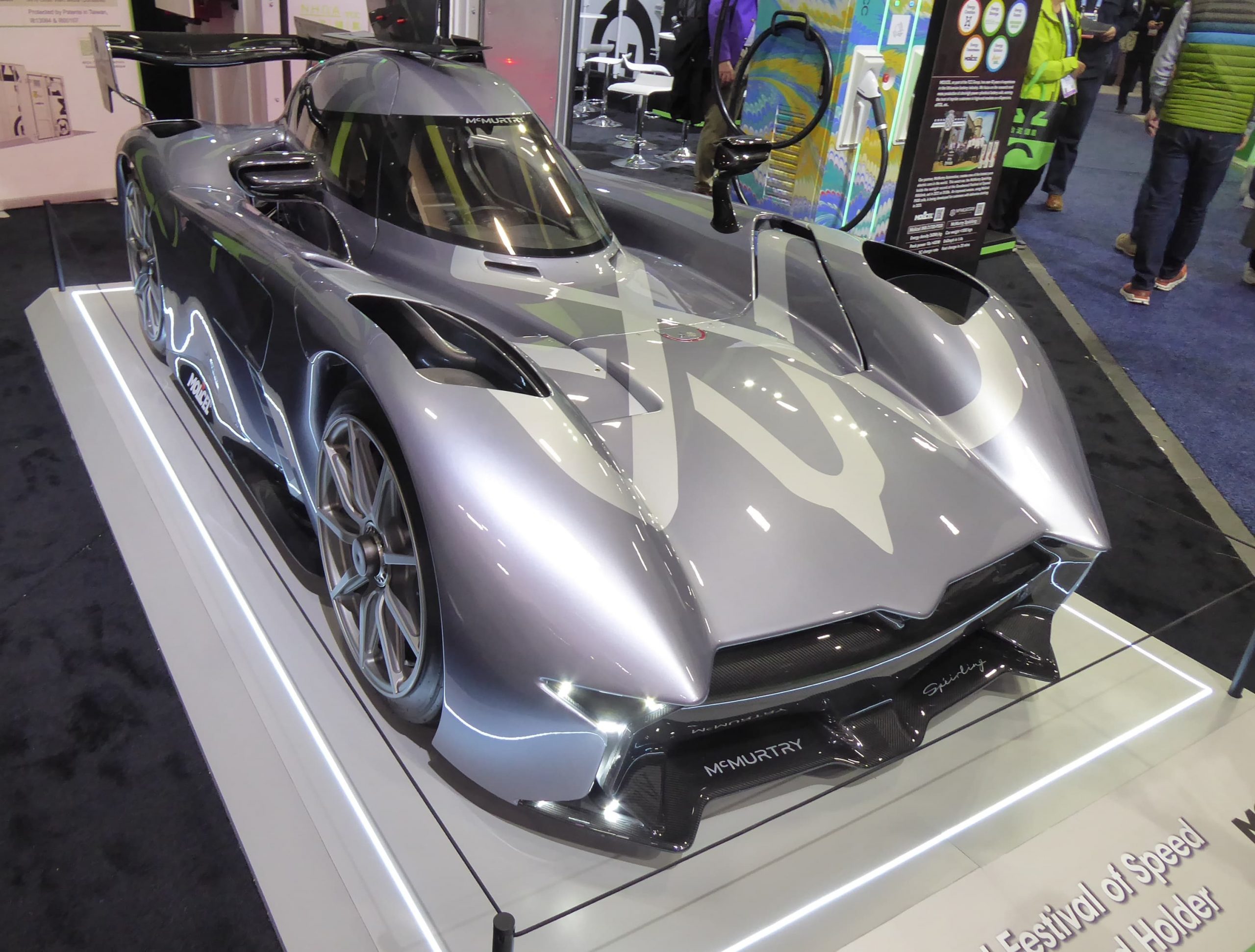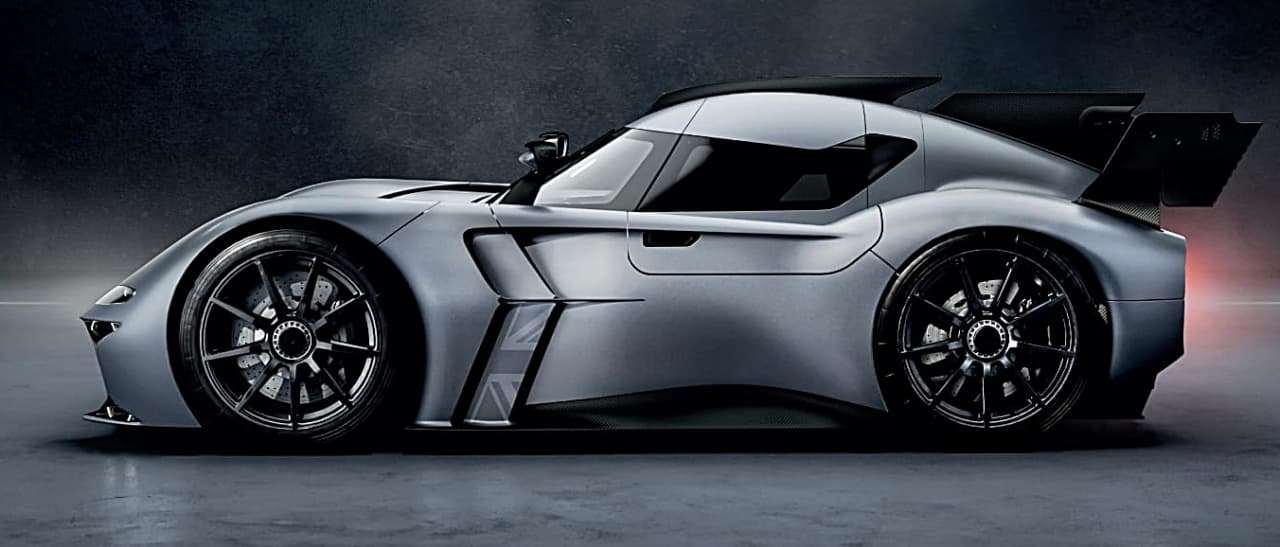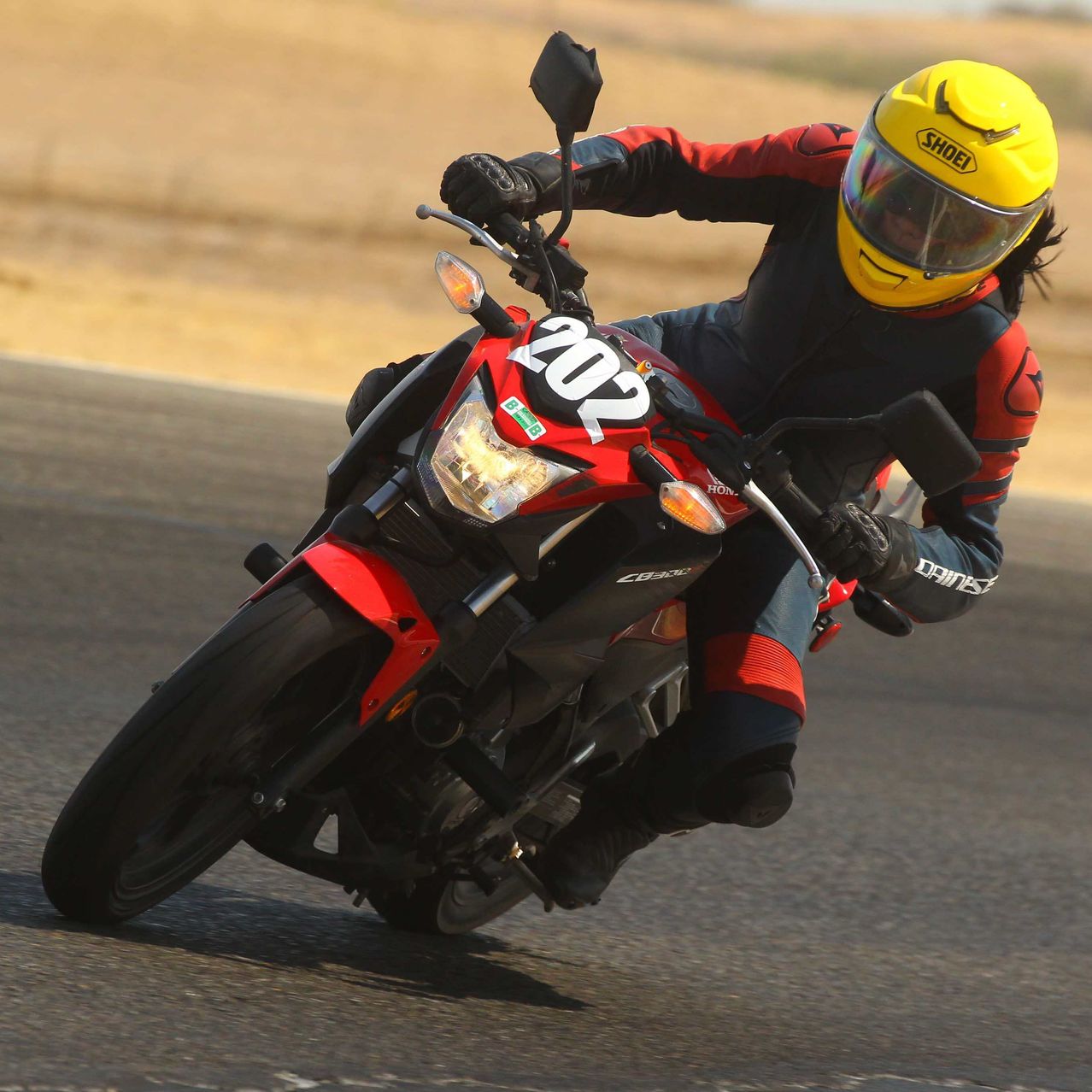The fastest cars you can buy are all electric. Cars with zero-to-60 times under two seconds are the Rimac Nevera and its close relative the Pininfarina Battista, the Tesla Model S Plaid Edition, and the Lucid Air Sapphire.
Now, add one more: the British-made McMurtry Spéirling. At a Silverstone track event in December, Mat Watson of the YouTube channel Carwows drove the electric, rear-wheel drive Spéirling PURE model to 60 miles an hour in 1.4 seconds, with zero to 100 in 2.63 and a quarter mile in 7.97. The PURE is a racer in an edition of 100, but McMurtry said it will eventually be producing a street-legal version.
The price in the U.K. for the handmade PURE is £895,000, and in the U.S. around US$1 million. McMurtry Automotive was founded in 2016 and based in England’s posh Cotswolds region of Gloucestershire. Managing Director Thomas Yates comes from Formula 1, and the company’s focus is on race-bred technology. Testing, in secret, occurred in the U.K. at tracks such as Castle Combe and Donington Park. The first reveal to the public was at the Goodwood Festival of Speed in 2021, with racers Derek Bell and Alex Summers giving demonstration runs. The next year, the PURE set a hill climb record at Goodwood (going up in 39.08 seconds).
Miller Motorcars of Greenwich, Connecticut, which also handles Ferrari, Bugatti, Maserati, Rolls-Royce, and other luxury brands, announced it was taking on McMurtry in January. The record-breaking car was shown by its battery supplier at CES in Las Vegas earlier this month, but will also be making an appearance in Greenwich, with an open house Feb. 3. The West Coast dealer is O’Gara Motorsport, and the star car was in California at Thermal Raceway earlier this month for a demonstration.

Jim Motavalli
Evan Cygler, director of special projects at Miller, tells Penta he was “completely dumbfounded” to encounter the rear-wheel drive McMurtry PURE in England. “They purposely came out with a finished car at Goodwood to break a record, and achieved the goal,” Cygler says. “The sound of it is incredible, as is the tiny size. We are passionate about our business, so we told them that if there was an opportunity to sell these cars, we’d love to be involved.”
Miller will support these track-only cars with its own track days at Connecticut’s Lime Rock Park, Cygler says. “It is less than two hours away and a fun place to host our customers for a day,” he says. “The Spéirling PURE is a cool weekend racer, and definitely something different. Whether you are into EV products or not, you have to love this.” Miller expects to get one or two PURE cars in 2025, he added. McMurtry will also host customers at private track events in the U.K.
The Spéirling reportedly offers 1,000 horsepower and 1,033 pound-feet of torque from two electric motors. Keeping it on the track are a pair of huge turbines (adapted from Formula 1 and Can Am) located behind the single occupant that extract air from under the car and produce more than 4,000 pounds of downforce. The battery is relatively small at 60 kilowatt-hours, but the carbon fiber-bodied car is so light at approximately 2,200 pounds that it has an estimated 300 miles of range (driven lightly, and on the forgiving European WLTP cycle). Top speed is around 200 mph.
The battery pack in the PURE prototype uses Molicel cells that can fast charge in 20 minutes, with rapid cell cooling. A charge can get the car around Silverstone track for 10 laps. Customer cars will use next-generation cells that are still in development.
The cockpit of the Spéirling PURE is a tight fit, and entry is made easier by a removable steering wheel. The single occupant sits on the rear fender and swings his or her body through the narrow opening, then drops into place. It’s a racer’s view forward, with no infotainment or anything else extraneous to ultra-high-speed driving. The Spéirling PURE may not be useful for getting groceries, but it offers the ultimate acceleration experience.
 Copyright 2020, Dow Jones & Company, Inc. All Rights Reserved Worldwide. LEARN MORE
Copyright 2020, Dow Jones & Company, Inc. All Rights Reserved Worldwide. LEARN MORE
What a quarter-million dollars gets you in the western capital.
Alexandre de Betak and his wife are focusing on their most personal project yet.
As Paris makes its final preparations for the Olympic games, its residents are busy with their own—packing their suitcases, confirming their reservations, and getting out of town.
Worried about the hordes of crowds and overall chaos the Olympics could bring, Parisians are fleeing the city in droves and inundating resort cities around the country. Hotels and holiday rentals in some of France’s most popular vacation destinations—from the French Riviera in the south to the beaches of Normandy in the north—say they are expecting massive crowds this year in advance of the Olympics. The games will run from July 26-Aug. 1.
“It’s already a major holiday season for us, and beyond that, we have the Olympics,” says Stéphane Personeni, general manager of the Lily of the Valley hotel in Saint Tropez. “People began booking early this year.”
Personeni’s hotel typically has no issues filling its rooms each summer—by May of each year, the luxury hotel typically finds itself completely booked out for the months of July and August. But this year, the 53-room hotel began filling up for summer reservations in February.
“We told our regular guests that everything—hotels, apartments, villas—are going to be hard to find this summer,” Personeni says. His neighbours around Saint Tropez say they’re similarly booked up.
As of March, the online marketplace Gens de Confiance (“Trusted People”), saw a 50% increase in reservations from Parisians seeking vacation rentals outside the capital during the Olympics.
Already, August is a popular vacation time for the French. With a minimum of five weeks of vacation mandated by law, many decide to take the entire month off, renting out villas in beachside destinations for longer periods.
But beyond the typical August travel, the Olympics are having a real impact, says Bertille Marchal, a spokesperson for Gens de Confiance.
“We’ve seen nearly three times more reservations for the dates of the Olympics than the following two weeks,” Marchal says. “The increase is definitely linked to the Olympic Games.”

Getty Images
According to the site, the most sought-out vacation destinations are Morbihan and Loire-Atlantique, a seaside region in the northwest; le Var, a coastal area within the southeast of France along the Côte d’Azur; and the island of Corsica in the Mediterranean.
Meanwhile, the Olympics haven’t necessarily been a boon to foreign tourism in the country. Many tourists who might have otherwise come to France are avoiding it this year in favour of other European capitals. In Paris, demand for stays at high-end hotels has collapsed, with bookings down 50% in July compared to last year, according to UMIH Prestige, which represents hotels charging at least €800 ($865) a night for rooms.
Earlier this year, high-end restaurants and concierges said the Olympics might even be an opportunity to score a hard-get-seat at the city’s fine dining.
In the Occitanie region in southwest France, the overall number of reservations this summer hasn’t changed much from last year, says Vincent Gare, president of the regional tourism committee there.
“But looking further at the numbers, we do see an increase in the clientele coming from the Paris region,” Gare told Le Figaro, noting that the increase in reservations has fallen directly on the dates of the Olympic games.
Michel Barré, a retiree living in Paris’s Le Marais neighbourhood, is one of those opting for the beach rather than the opening ceremony. In January, he booked a stay in Normandy for two weeks.
“Even though it’s a major European capital, Paris is still a small city—it’s a massive effort to host all of these events,” Barré says. “The Olympics are going to be a mess.”
More than anything, he just wants some calm after an event-filled summer in Paris, which just before the Olympics experienced the drama of a snap election called by Macron.
“It’s been a hectic summer here,” he says.

AFP via Getty Images
Parisians—Barré included—feel that the city, by over-catering to its tourists, is driving out many residents.
Parts of the Seine—usually one of the most popular summertime hangout spots —have been closed off for weeks as the city installs bleachers and Olympics signage. In certain neighbourhoods, residents will need to scan a QR code with police to access their own apartments. And from the Olympics to Sept. 8, Paris is nearly doubling the price of transit tickets from €2.15 to €4 per ride.
The city’s clear willingness to capitalise on its tourists has motivated some residents to do the same. In March, the number of active Airbnb listings in Paris reached an all-time high as hosts rushed to list their apartments. Listings grew 40% from the same time last year, according to the company.
With their regular clients taking off, Parisian restaurants and merchants are complaining that business is down.
“Are there any Parisians left in Paris?” Alaine Fontaine, president of the restaurant industry association, told the radio station Franceinfo on Sunday. “For the last three weeks, there haven’t been any here.”
Still, for all the talk of those leaving, there are plenty who have decided to stick around.
Jay Swanson, an American expat and YouTuber, can’t imagine leaving during the Olympics—he secured his tickets to see ping pong and volleyball last year. He’s also less concerned about the crowds and road closures than others, having just put together a series of videos explaining how to navigate Paris during the games.
“It’s been 100 years since the Games came to Paris; when else will we get a chance to host the world like this?” Swanson says. “So many Parisians are leaving and tourism is down, so not only will it be quiet but the only people left will be here for a party.”















